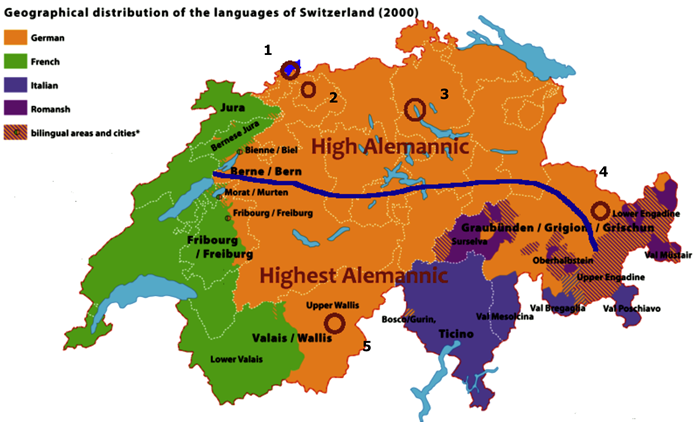8.5: Aussprache
- Page ID
- 103799
Kapitel 8: Regional Dialects in Switzerland - SCHWEIZERDEUTSCH (Schwiizerdütsch)
In the previous chapter we explored the different dialects in Germany. This chapter takes a closer, though only partial, look at the different Swiss German dialects. Below is a map of Switzerland indicating the different languages and dialects spoken.

As you can see, Switzerland has four main languages and four main language areas (although most Swiss people are multilingual): Swiss-German is spoken in the middle part of Switzerland, Swiss-French is mostly spoken in the West and South-West, Italian in the Kanton Tessin and Retho-Romanisch (a Latin derivative) in the Kanton Graubünden (a canton is Switzerland’s political unit, like a state in Germany or Austria). In this chapter we concentrate on the Swiss German "part" of Switzerland.
The thick line in the picture above approximates the division between the High- and Highest Alemannic dialect areas. This does not mean that in each of the speech region only one dialect is spoken. On the contrary, dialects differ within the two regions as well as between Kantone, or even within a Kanton, to the point where neighboring townships might have quite distinct dialects. If you are interested in listening to samples from the different regions you can find them at http://www.dialekt.ch/default.htm. Here we will focus on a few varieties of Swiss German.
Let’s take a brief look at the dialectal differences. The five circles (numbered to match the following table) in the above picture illustrate the dialect diversity that exists in Switzerland.
| English | German | 1. Basel-City | 2. Basel-Canton | 3. Zürich | 4. Graubünden | 5. Wallis |
| understand | verstehen | verstoo | verstaa | |||
| bag | Tüte | Sagg | Sak | |||
| not | nicht | nit | nööd | net | ||
| cold | kalt | kiel | chalt | |||
| we go | wir gehen | mir gönd | miar göönd | wiär gääh | ||
| church | Kirche | Chillä | Kircha |
Schweizerdeutsch is the national variety of German spoken in multilingual Switzerland (which also recognizes French, Italian, and Romansch as national languages). Due to its location (i.e., to the southwest of Germany, Switzerland underwent the High German sound shift just as southern Germany and Austria did. However, as a result of its constant exposure to other languages (especially French), Schweizerdeutsch has a unique sound as well as unique vocabulary, which distinguishes it from the other Upper German dialects.
| Dialect features | Beispiele (Standard German Dialect) |
|---|---|
|
|
|
|
|
|
|
|
|
|
|
|
|
|
|
|
|
|
|
|
|
|
|
|
Note: A German dialect resembling Swiss German is spoken in France on the border of France, Switzerland and Germany. This dialect is called Elsäsisch (Alsacian).


